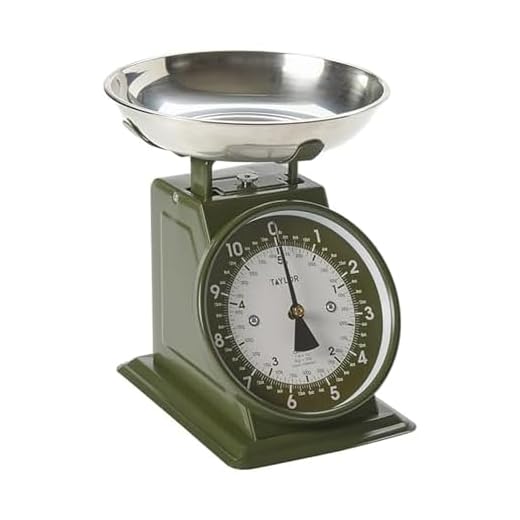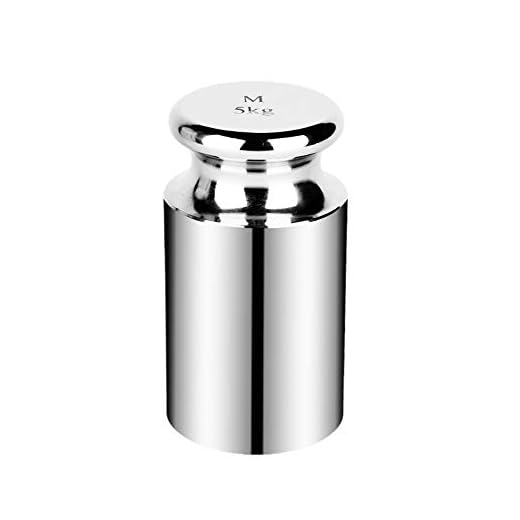







For precise measurements, always ensure the device is on a flat surface before use. Any uneven ground can lead to inaccurate results, so it’s crucial to find a stable spot.
Regularly calibrate your instrument using known weights. A simple adjustment can significantly enhance accuracy. If the reading is off, check the mechanism for dust or debris, which can interfere with functionality.
For optimal results, load items centrally to maintain balance. Off-center placements can lead to skewed readings, impacting your total count. A consistent method also helps in tracking belongings effectively.
Keep an eye on the maximum capacity indicated on the device. Overloading can damage internal components, leading to costly repairs or replacements. Always opt for a weight that’s comfortably within limits.
Calibrating Your Antique Weighing Device
Ensure precision by regularly calibrating your vintage measuring tool. Utilize standardized weights for calibration. Place the reference weight on the platform, and adjust the scale until it shows the correct mass. If calibration is off, small discrepancies can lead to significant errors during actual measurements.
Using Weights for Accurate Measurements
To confirm the reliability of readings, test the mechanism using known weights before weighing your belongings. If multiple readings are obtained, calculate the average for a more accurate result. This approach compensates for any inconsistencies in the tool’s performance.
Transferring Mass to Different Containers
For items that exceed the platform’s capacity, weigh in manageable portions and sum the results. This method avoids overload and potential damage to the measuring device. Keep a notebook handy to record each individual weight for later reference.
Understanding Environmental Factors
Temperature and humidity can influence the performance of mechanical measuring instruments. Conduct measurements in an environment with stable conditions to reduce variability. A flat, solid surface protects against external factors that could skew results.
Maintaining Your Weighing Device
Routine maintenance prolongs the life and accuracy of your device. Dust the surface and check for wear on springs and levers. Lubricate moving parts gently to prevent sticking and ensure smooth operation. Keep it covered when not in use to avoid debris accumulation.
Reading the Scale Correctly
Pay attention to the markings on the display. If the apparatus includes a dial, align your line of sight with it to avoid parallax errors. If reading is unclear, gently rock the item to settle it before taking a measurement. This practice avoids misinterpretation of the reading.
Choosing the Right Antique Weighing Device for Baggage
Prioritize simplicity and accuracy in selecting a vintage measuring tool. Look for models that have a clear and easy-to-read dial, preferably with both metric and imperial markings. This ensures flexibility depending on your travel needs.
- Material Quality: Opt for devices made from durable materials like solid metal or high-quality plastic. These are more likely to withstand travel wear and tear.
- Calibration: Check if the measuring device allows for easy adjustment. Devices that can be calibrated ensure that you consistently receive precise readings.
- Capacity Limits: Select an option that accommodates your heaviest items. Most antique units have a specified maximum weight; exceeding this can lead to inaccurate measurements or damage.
- Portability: Consider the size and weight of the device itself. A compact and lightweight option will be easier to transport.
- Verification of Functionality: Test the mechanism before purchase. A functional scale will deliver consistent readings with minimal effort.
- Authenticity: Verify the age and history of the piece, especially if it is being purchased for aesthetic value in addition to functionality.
Research availability through antique shops, flea markets, and online platforms. Compare various models to find the one that best suits your requirements for travel and vintage appeal.
Calibrating Your Old Scale Accurately
For precise measurements, ensure your equipment is calibrated correctly before use. Begin by placing a known weight, such as a dumbbell or a bag of flour, onto your device. This weight should be within the capacity of the instrument.
If the reading is off, adjust the calibration knob or reset the mechanism according to the manufacturer’s instructions. Many classic models feature a sliding weight or adjustment screw. Turn it slowly while observing the display until the correct measurement is shown.
Repeat this process with multiple weights to confirm consistency across various values. If discrepancies persist, consider cleaning the internal mechanics to remove any dust or debris that could interfere with functionality.
On occasion, it might be necessary to weigh items that are not standard measures. In such cases, take notes of adjustments made, as this can serve as a quick reference for future calibrations. Ensuring the equipment remains on a flat and stable surface will yield the most reliable results.
Lastly, while sharpening your measuring technique, it’s useful to remember other equipment aspects, such as how to handle transportation concerns for shared items, as highlighted in this article: how can a father win custody.
Techniques for Ensuring Accurate Weight Measurement
Utilize a flat and stable surface for optimal readings. Avoid uneven or soft flooring that can affect the accuracy of your results.
Consider using a level to ensure the surface is perfectly flat. An inclined platform will yield inconsistent outcomes.
Take measurements at various times of the day. Variations in temperature and humidity can subtly influence the performance of certain instruments.
To eliminate discrepancies, it’s advisable to weigh the item multiple times, averaging the results for the most reliable figure.
Keep your measuring instrument clean and free of debris. Dust or moisture on the platform can skew readings.
For precise outcomes, always make sure that the object being measured is centered on the platform. Off-center placement can lead to inaccurate readings.
Before use, ensure your instrument is calibrated. If you notice persistent inaccuracies, consider recalibrating or seeking repairs.
- Check for the manufacturer’s guidelines on maintenance and adjustments.
- Use known weights for testing accuracy.
For travelers looking for suitable carriers, refer to the best luggage for usa to europe for additional information.
Avoiding Common Mistakes with Old Scales
Check the surface where your weighing device sits. An uneven or soft surface can lead to inaccurate readings. Ensure it’s placed on a hard, flat area for reliable results.
Always interact with the platform before measuring your item. A shaky or wobbly base can skew the results. Stand still and let the apparatus settle to capture an accurate number.
Prior to taking any readings, inspect the device for signs of wear. If there are visible damages or rust, the accuracy can diminish. Performing a brief maintenance check can prevent these discrepancies.
Be mindful of excess items that might affect the count. Ensure that only the target object is on the platform without any stray items or debris, which can add unnecessary weight.
Familiarize yourself with the specific increments your device measures. Some may not show decimals; knowing this can help in understanding precision while ogling smaller objects.
Consider the temperature and humidity of the environment. Extremes can impact both the scale’s performance and the object being weighed. Aim for a stable condition to produce consistent measurements.
Consult the user guide if available. Instructions specific to your device model can reveal unique features or operating methods that enhance accuracy.
Be cautious with calibration; improper adjustments can lead to compounded errors. Recalibrate only when necessary, following clear instructions, to mitigate risks of inaccuracies.
Interpreting Weight Readings on Different Scale Types
Understanding measurements varies significantly across various models. Each type operates under distinct principles, leading to potential discrepancies. Familiarize yourself with the following categories:
Mechanical Models
Mechanical or analogue types rely on springs, utilizing a needle to indicate parameters. Ensure proper zeroing by adjusting the dial before placing your item. Readings can fluctuate with humidity or temperature changes, so consider the environment while assessing results. Regular maintenance, such as lubrication and cleaning, will enhance performance.
Electronic Variants
Electronic counterparts provide digital formats for readings, often featuring auto-calibration functions. They usually offer higher precision and are more sensitive to small variations. To optimize accuracy, ensure they are on a flat surface and allow for a short warm-up period before use. Keeping the sensor clean will prevent erroneous outputs.
| Scale Type | Key Features | Common Issues |
|---|---|---|
| Mechanical | Simple, no batteries, durable | Environmental sensitivity, requires calibration |
| Electronic | High precision, easy to read, often includes additional features | Battery dependency, may require regular calibration |
Awareness of these characteristics will better inform your choices during measurement. Carefully consider the appropriate model based on your specific needs and the potential for variations in readings.
Maintaining Your Old Scale for Long-Term Use
Store the instrument in a dry, cool place to prevent rust and damage from humidity and temperature fluctuations.
Regularly clean the surface with a soft, damp cloth to avoid dirt accumulation, ensuring that measurements remain accurate.
Avoid harsh chemicals that may corrode materials. Instead, use mild soap solutions for tougher spots.
Periodically inspect all moving parts for wear and tear. Lubricate joints with appropriate oil to facilitate smooth operation.
Check calibration frequently. If discrepancies are noticed, recalibrate using verified weights to maintain precision.
Keep the instrument level when in use. An uneven surface can lead to incorrect readings and long-term inaccuracies.
Consider using protective covers to shield the surface from dust and impact damage while not in use. This preserves both functionality and longevity.
FAQ:
What tips can I use to weigh my luggage accurately with an old scale?
To achieve accurate measurements with an old scale, first ensure the scale is placed on a flat, stable surface. Check if the scale is balanced; if it has a dial, make sure it’s at zero before weighing. If you’re weighing luggage directly, lift your bag and set it gently on the scale to avoid any sudden shifts. Alternatively, you can weigh yourself first, then weigh yourself holding the luggage and subtract your weight from the total. This method can help if the scale has a small platform or is sensitive.
How can I improve the precision of weighing luggage on an old scale?
Improving precision on an old scale can be done by calibrating it. Start by finding small weights, or even known items like canned goods, to test against the scale. If the readings are off, you may adjust the scale if it has adjusting screws or simply take note of any discrepancies. Another tip is to weigh your luggage multiple times, recording the readings, and using the average for a more reliable measurement. Lastly, minimize any movement or vibration while taking the reading, as this can influence the outcome.
Are there specific types of old scales that are better for weighing luggage?
Yes, certain types of old scales are more suited for weighing luggage. Mechanical spring scales are often preferred due to their simplicity and ability to handle various weights. Platform scales, which can accommodate larger and heavier items, are also a good choice. It’s beneficial to avoid old-fashioned scales with intricate mechanisms or those that seem to have wear and tear, as they may not provide accurate readings anymore. Checking the scale’s maximum weight limit is crucial to ensure it can handle your luggage without any issues.







